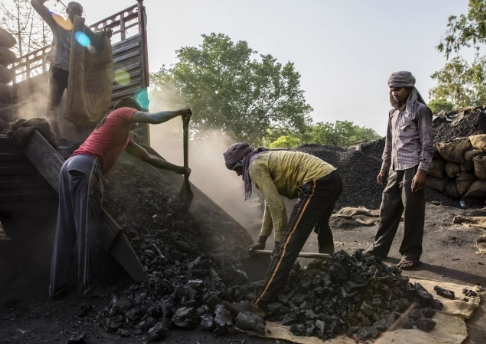Modi vs Workers: Destruction of Protective Labour Laws Begins

Image Courtesy: BloombergQuint
With the passing of the Code on Wages in Lok Sabha on July 30, 2019, the dismantling of existing protective framework for workers has begun in right earnest. The passed Code will have to go to Rajya Sabha for approval before it becomes a law. But with the way different parties are behaving, kowtowing to the government in power, it may well get passed in the Upper house also. The passed wage code replaces four existing labour laws related to minimum wages and bonus. The pending code on occupational health, safety and working conditions will replace 13 other laws, including the Factories Act, and a slew of acts pertaining to different sections of workers like beedi and cigar, cinema, sales promotion, migrants, construction workers, etc.
Three essential features of wages are being changed through the newly passed Code on Wages (CW). These are: how the minimum wage will be calculated, what will be a working day and by what means will law be enforced. Taken together, the changes in these issues effectively destroy the protective nature of labour laws relating to wages. The spirit behind the earlier laws was that workers are disadvantaged sections who are socially and economically unable to counteract the pressure of exploitation from employers and hence they need protective legislation. The new thinking, as enshrined by the Modi government, in the new Codes is that such protection should be abandoned and a free hand should be given to employers to extract the maximum labour out of hapless workers with the minimum of compensation.
How is Minimum Wage Calculated?
According to the newly passed Code, minimum wages will be calculated and fixed by the Central or State governments (“appropriate government”) by considering certain factors that are given in section 6, sub-section 6 of the Code. The wording is important so here is the text of the section (emphasis added):
Section 6 (6) For the purpose of fixation of minimum rate of wages under this section, the appropriate Government, —
(a) shall primarily take into account the skill of workers required for working under the categories of unskilled, skilled, semi-skilled and highly-skilled or geographical area or both; and
(b) may, in addition to such minimum rate of wages for certain category of workers, take into account their arduousness of work like temperature or humidity normally difficult to bear, hazardous occupations or processes or underground work as may be prescribed by that Government; and
(c) the norms of such fixation of minimum rate of wages shall be such as may be prescribed.
Note that the primary factors are skills and/or geographical area – that’s why clause (a) says ‘shall’. It is mandatory to consider these two factors. In the next clause, it says the government ‘may’ (not mandatory) arduousness of work, hazardous or underground work. Finally, in clause (c), it is said that norms for fixing wages ‘may’ be such as prescribed.
What does all this mean? It means that minimum wages will be based on skill, and maybe also take into account if the work is very hard. That’s it.
Through this single new provision, the Modi government has demolished the whole edifice of working out minimum wages based on how much a worker and his/her family need to survive (minimum wage is for survival only, it is not a fair wage). Way back in 1957, the 15th Indian Labour Conference (comprising of representatives of trade unions, employers and government) had decided on a detailed method of calculating minimum wages based on the fact that each adult worker would need at least 2,700 kcal per day of food, and also clothing, shelter, other consumables (like soap), fuel, rent, transport, etc. A four-member family (two adults and two children) were considered a unit for this calculation. This became the basis of all minimum wage calculations. In 1992, the Supreme Court (in Reptakos Brett), while affirming this method of calculating minimum wages pointed out that key elements of expenditure like children’s education, entertainment and leisure, occasions like marriage, etc. were not being covered by this method and directed that henceforth, 25% of the first calculation should be added to cover these aspects. This then became the norm which was affirmed and used throughout the country for fixing the minimum wage rates. It was reaffirmed as recently as 2016 in the 46th ILC which was inaugurated by Modi himself.
All this is out of the window now. The new statute itself lays down what should be the factors taken into account for fixing wages and they don’t include any of the earlier methodology. It may be argued that the government has the right – under clause (c) – to retain this methodology. But why not make it part of the statute then?
How Many Hours of Work?
All protective legislation for workers across the world ensures that a work day will consist of eight hours (or 48 hours a week) with a rest day every week. Any work done beyond this will be considered overtime work and will be paid for at double the normal hourly rate. Although the MWA had not specified this, rules framed under it did specify the eight-hour work day. In addition, other legislation like the Factories Act clearly specified that the work day will be of eight hours.
This is important because wages are usually paid according to number of work days, and additional work needs to be paid for at double rates. The amount of wages a worker receives is intrinsically linked to the number of hours of work.
In the Code on Wages, the same definition as the earlier one (in MWA) is used – that the appropriate government will decide what will make up the normal working day. But the Modi government’s intention to dilute the eight-hour working day norm is clear from the other Code on Occupational Safety, Health and Working Conditions which replaces the Factories Act provision (in Section 51) of 8-hour working day by saying that the appropriate government. will decide the number of hours of a normal working day. Here’s what the Code says (emphasis added):
Section 25. (1) No worker shall be required or allowed to work, in any establishment or class of establishments for more than—
(a) such period as may be notified by the appropriate Government;
(b) such hours in a day as may be notified by the appropriate Government subject to the period specified in clause (a); and
(c) the periods of work in each day shall be so fixed as not to exceed such hours, with such intervals within such period, as may be notified by the appropriate Government.
Again, instead of incorporating the existing limit of eight-hour working day as extant, the Code leaves it to the government to decide on the hours of work. Why? The purpose is to force workers to work more hours per normal working day without having to take his/her consent and without having to pay double overtime rate.
How is the law going to be enforced?
After destroying the core matters – calculation of wage and hours of work – through the new Codes, the Modi government was keen to ensure that the industrialists will not be harassed by any government enforcement machinery based on complaints by workers. So, the present machinery of labour inspectors who could check violations and prosecute has been further whittled down. In fact, the very nomenclature has been changed. Inspectors will now be called Inspectors-cum-Facilitators!
Why ‘facilitators’? Because, the new Code says (emphasis added):
Section 51. (5) The Inspector-cum-Facilitator may ––
(a) advice to employers and workers relating to compliance with the provisions of this Code;
(b) inspect the establishments as assigned to him by the appropriate Government, subject to the instructions or guidelines issued by the appropriate Government from time to time.
So, now the inspector cum facilitator has to advice both employers and workers – he/she is not supposed to check violations alone. In fact, a detailed system of inspection procedure is laid out which specifies that a “web-based inspection” system may also be put in place. The government will decide which locations need to be inspected, on a “randomised” basis. Many of these methods are already in place in several states but now all this will become part of Central legislation.
Inspectors can also inspect records, make enquiries and impose fines after reporting it to the appropriate senior authorities. But they will have to give time to the violators to mend their ways first. Also, new provisions for compounding – coming to a mutual compromise – have been introduced in section 56. This means that employers and workers can reach a mutual compromise and settle a dispute on wages or bonus etc. Given the highly unequal relationship between employer and worker, this effectively will lead to workers being forced to accept some compromise on what are their rights.
Apart from these three crucial changes that shift the balance of the worker-employer relationship decisively in favour of the employer, the new Codes do away with many small rights available to different sections of workers.
In sum, the Modi government has finally started the process of removing all protection available to workers from rapacious employers. The two new Codes, and the other two which are on the anvil, will effectively undo all the gains made by the workers through their struggles over the past century.
Also read: 'Proposed Labour Codes Will Further Destroy Workers’ Rights’
Get the latest reports & analysis with people's perspective on Protests, movements & deep analytical videos, discussions of the current affairs in your Telegram app. Subscribe to NewsClick's Telegram channel & get Real-Time updates on stories, as they get published on our website.
























